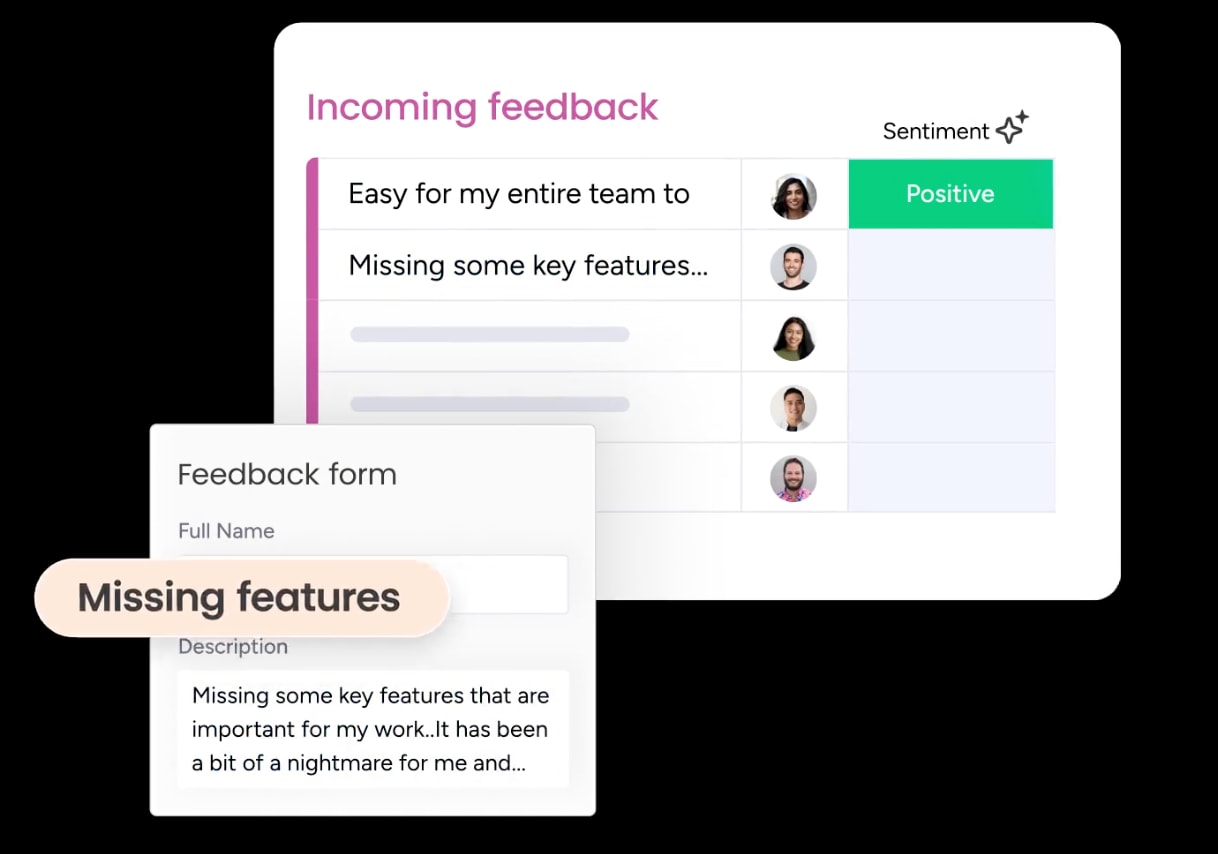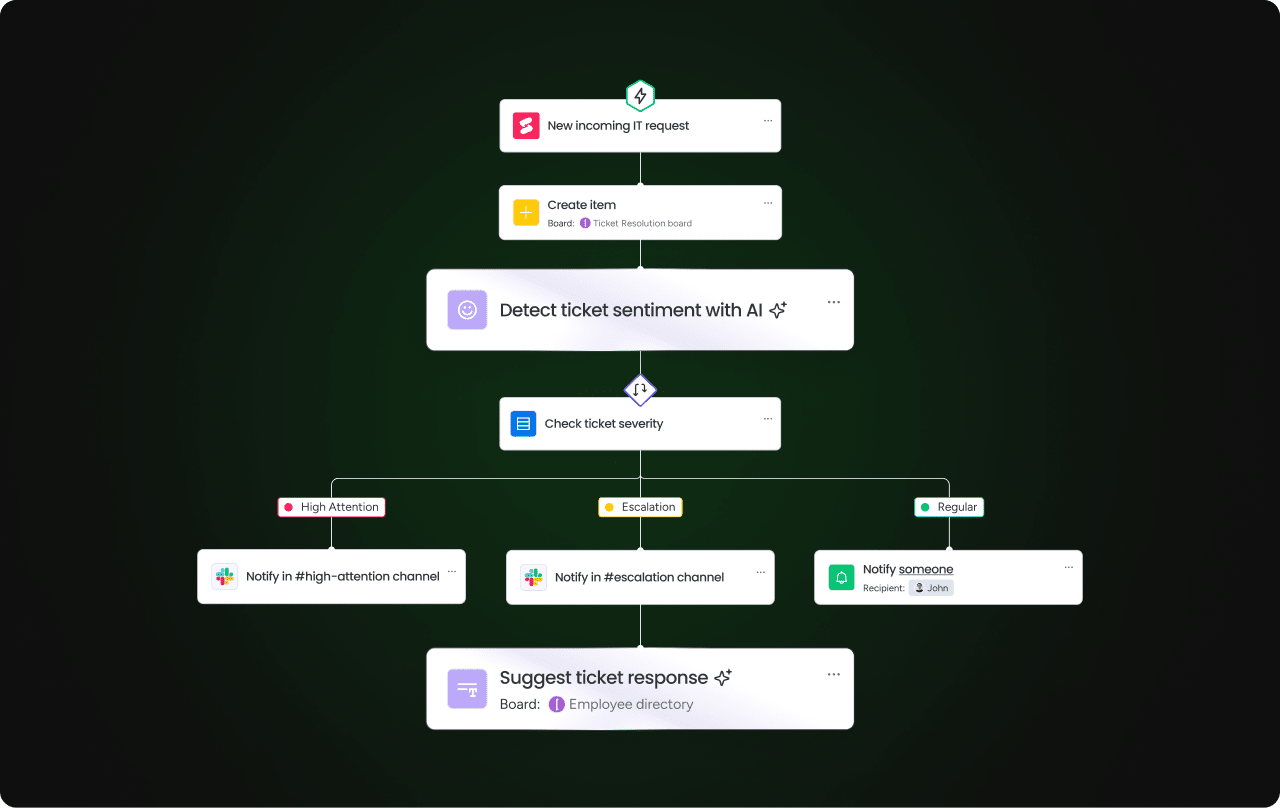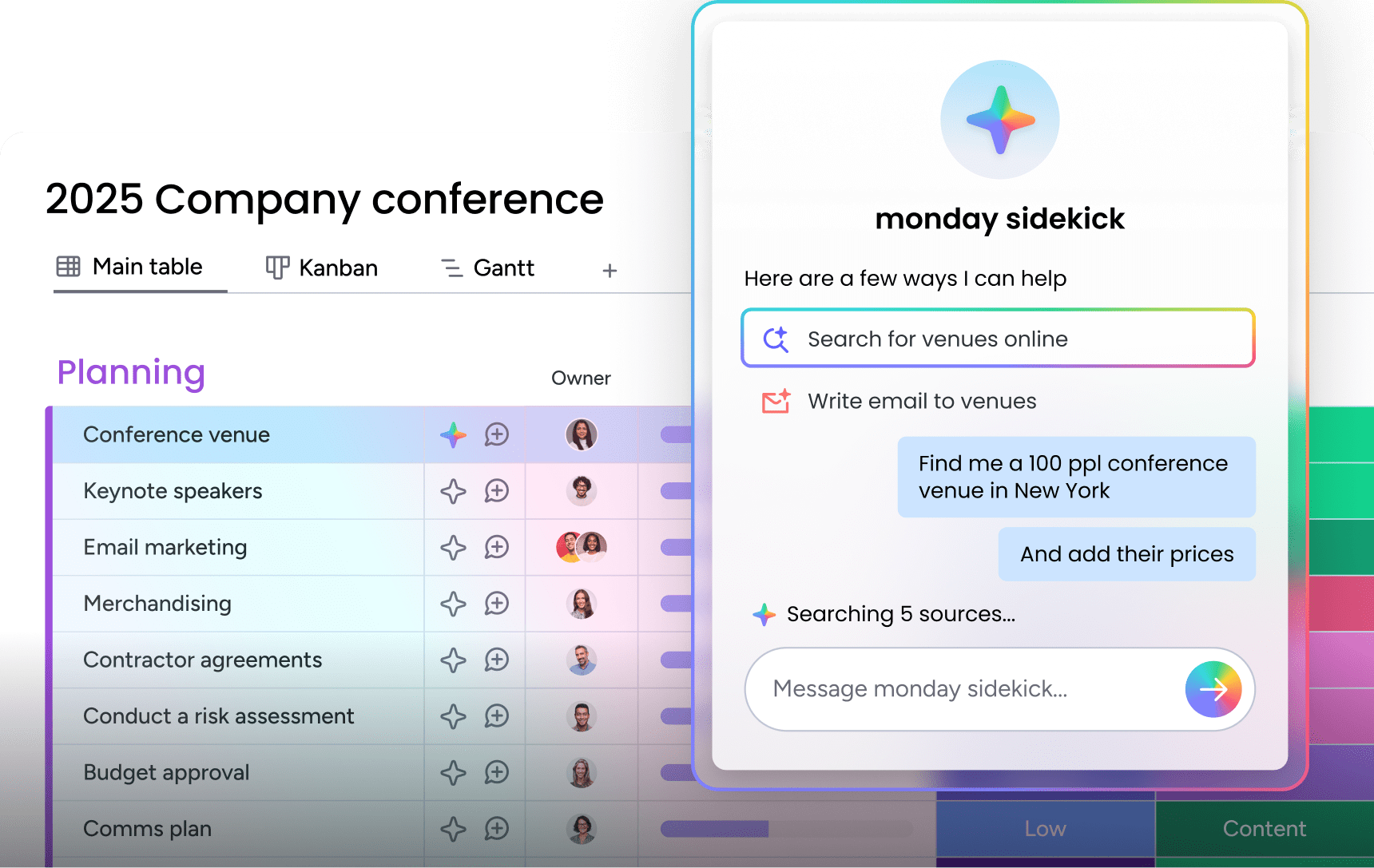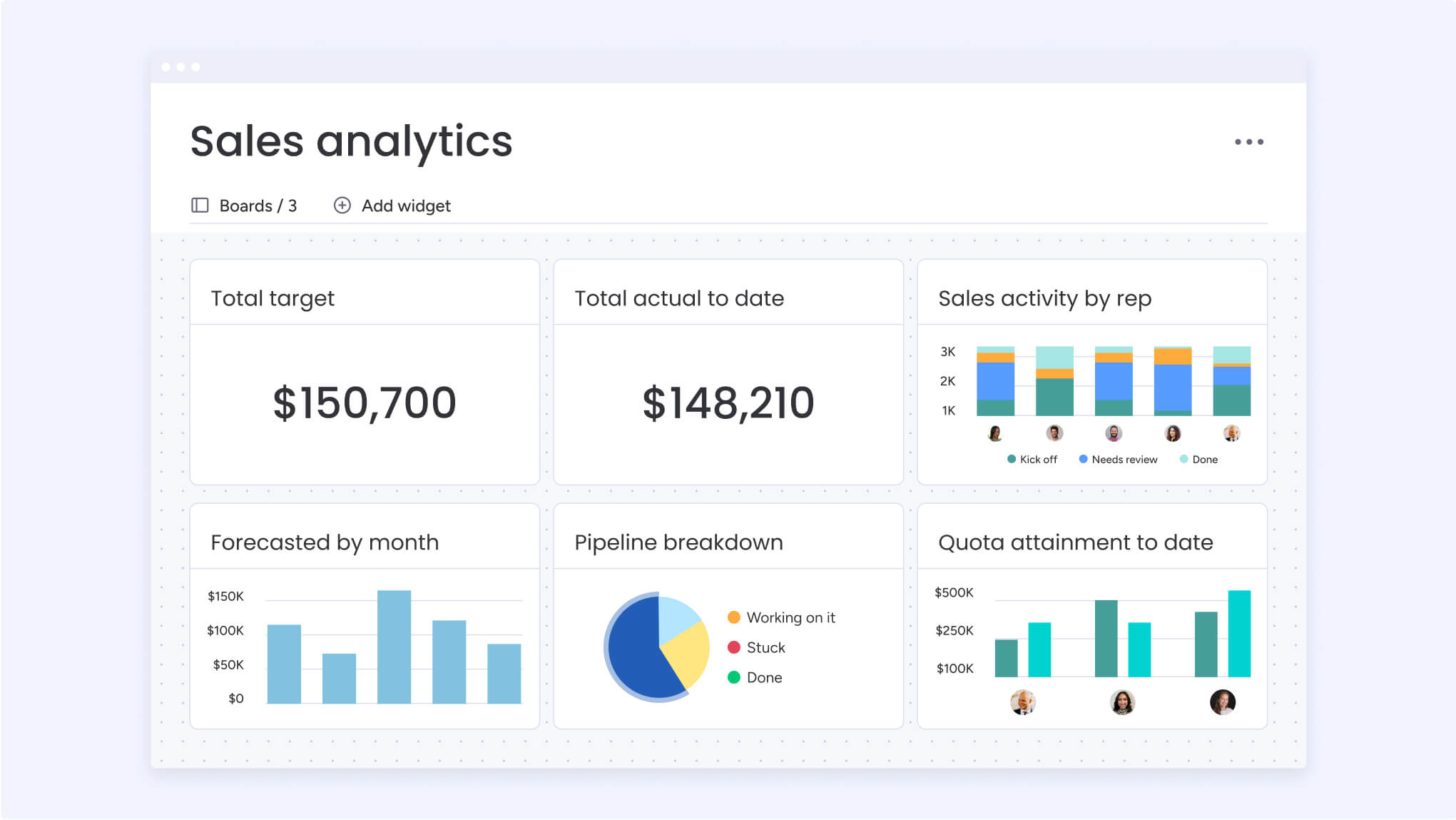Every customer interaction carries emotion, whether hard to detect or impossible to miss. But few teams have the time to sift through hundreds or thousands of interactions to decode how customers feel. That’s where sentiment analysis tools come in.
These tools quickly detect and interpret customer emotions toward your brand, products, or services giving teams the insights they need to boost loyalty, satisfaction, and revenue.
In this article, we’ll go deeper into what sentiment analysis is and how it works, while also looking at a few of the leading sentiment analysis tools, including how a platform like monday CRM can help teams turn sentiment into actionable insights.
Try monday CRMWhat are sentiment analysis tools?
Sentiment analysis uses AI and machine learning to interpret emotions in digital text — from emails and chat transcripts to social media comments and online reviews. Instead of manually parsing tone or intent, sentiment analysis tools automatically classify language as positive, negative, neutral, or even map it to emotions like joy, frustration, or anger.
For businesses, these insights go beyond surface-level feedback. By revealing how customers truly feel about their brand, products, or experiences, sentiment analysis helps teams improve loyalty, strengthen reputation, and uncover new opportunities for growth.
How AI and automation deliver deeper customer insights
Sentiment analysis relies on AI to capture emotions and insights from digital text. There are certain AI and automation features that most sentiment analysis tools offer, and others that you should look for when considering different solutions. Below, we’ll look at some critical features and AI automations to seek out in sentiment analysis software.
- Huge dataset management: Look for a platform that can process and analyze content from millions of sources, and simultaneously get a complete picture of customer feedback.
- Real-time alerts: The platform you choose should offer automated monitoring that provides alerts in real time when there are negative sentiment spikes so your team can respond quickly.
- AI summarization: Look for AI automations that can instantly summarize large volumes of feedback into concise insights that highlight key themes and trends.
- Multi-language analysis: For global brands, it’s essential to have AI-powered language models that can analyze sentiment in dozens of languages and account for cultural context.
- Sentiment scoring and ranking: Look for AI automation features that can assign scores to text to make it easier to compare sentiment over time and make it easier to address high-priority cases.
- Custom model training: If you need industry-specific sentiment analysis, look for a tool that offers custom model training so that data improves over time on special terminology, products, or language patterns.
- Text nuance detection: Sometimes detecting basic sentiment isn’t enough, so find a solution that can also understand and offer insights on nuance like sarcasm, context, or ironic language.
Understanding the different types of sentiment analysis
Sentiment analysis tools do more than just determine if a text is positive or negative. These tools use smart features to detect specific emotions and intentions, giving teams a clear path on how to intervene or improve certain experiences. Here’s a look at the four core types of sentiment analysis:
Fine-grained analysis
Fine-grained analysis involves dividing text into emotions that go beyond “positive” or “negative” to get to all the grey zones in between. Generally, this type of analysis rates text sentiment on a wider sliding scale, where different metrics represent whether sentiment was very positive, positive, neutral, negative, or very negative.
Aspect-based analysis
With aspect-based analysis, tools will focus on pinpointing the sentiment of a product or service’s specific feature. This helps companies hone in on how customers feel about each element individually. For example, a company might use aspect-based analysis to understand how software users feel about a recent update.
Emotion detection
Aside from determining whether a text is positive or negative, sometimes organizations want to understand more specific emotions and understand the person’s psychological state when they wrote a text. Emotion detection works to identify more complex feelings, such as anger, regret, frustration, joy, or surprise.
Intent analysis
Intent analysis takes things a step further by determining the sentiment and then attempting to decipher a user’s intent behind what they wrote. For example, if a user wrote an email to a company complaining about the checkout process on their website, an intent analysis tool might pick up on the fact that the user’s goal was to complete a purchase.
5 top sentiment analysis tools for better CX
There are dozens of great sentiment analysis tools on the market. Knowing which one to use for your organization isn’t always intuitive: Do you need social listening or customer feedback analysis? To help narrow down your decision, we’ve collected a sampling of the leading sentiment analysis tools that can be used for different use cases.
The table below shows each platform side-by-side, or you can keep scrolling to get a detailed overview of each.
| Platform | Use case | Starting price | G2 rating |
|---|---|---|---|
| monday CRM | Integrated AI CRM with basic sentiment tracking | $12/seat/month (billed annually) | 4.6/5 (G2) |
| Sprout Social | All-in-one social media management with sentiment analysis | $199/seat/month (billed annually) | 4.4/5 (G2) |
| Semantria by Lexalytics | Enterprise text analytics and custom sentiment models | Custom pricing | 4.4/5 (G2) |
| Chattermill | Multi-channel customer experience feedback analysis | Custom pricing | 4.5/5 (G2) |
| Brandwatch | Enterprise social intelligence with competitive insights | Custom pricing | 4.4/5 (G2) |
1. monday CRM
Use case: Integrated AI CRM with sentiment analysis

Offering a comprehensive customer relationship management platform, monday CRM includes sentiment analysis features alongside other advanced CRM software functionality. Teams can track customer sentiment throughout the entire customer journey and get valuable insights into customer satisfaction levels that can be used to inform sales journeys and engagement strategies.
Key features
- Built-in AI writer can compose emails and adjust tone based on customer sentiment for personalized messages that resonate
- Omnichannel integration with over 200+ work apps allows teams to sync feedback from other sentiment analysis tools and social channels
- AI-powered custom dashboards and reports display sentiment metrics alongside sales performance data
Pricing
- Free 14-day trial
- Plans starting from $12/seat/month (billed annually)
Learn more about monday CRM plans and pricing.
What users are saying
G2 rating: 4.6/5
“I’ve been using Monday CRM primarily for sales tracking, client management, and communications, and it’s been a solid tool for keeping everything organized and accessible in one place. What I like most is how easy it is to use once everything is set up. The interface is clean, intuitive, and makes day-to-day tasks like updating client info or tracking progress straightforward. It’s helped streamline how I manage leads and client communications, and it’s made a noticeable difference in keeping things on track.” — Cynthia F.
Try monday CRM2. Sprout Social
Use case: All-in-one social media management with sentiment analysis
Sprout Social is one of the leading social media management platforms with sentiment analysis capabilities. Companies use Sprout Social to monitor brand mentions across social media channels. Its AI-powered sentiment engine can distinguish between positive, negative, and neutral sentiments with high accuracy, while also identifying specific emotions like joy, anger, or frustration so that brands can respond appropriately to customer feedback and manage their online reputation.
Key features
- AI-powered sentiment analysis helps teams capture nuance in text and emojis to hone in on customer emotions
- Multilingual sentiment analysis allows global brands to gather data on customer feedback in different languages and locations
- Sentiment scoring gives teams insights into average sentiment over time to see if it’s trending positively or negatively
Pricing
- Free 30-day trial
- Plans starting from $199/seat/month (billed annually)
What users are saying
G2 rating: 4.4/5
“I love how I can easily track social performance, bulk schedule content, engage with our community and monitor brand sentiment. I like the performance snapshot in the homepage and the internal reports. They give me clarity on what works and doesn’t and how efficient I am.” — Christianna P.
3. Semantria by Lexalytics
Use case: Enterprise text analytics and custom sentiment models
Semantria by Lexalytics uses advanced natural language processing and machine learning to analyze text from sources like surveys, reviews, and support tickets, making it ideal for enterprises with complex datasets or compliance needs.
Key features
- Industry-specific sentiment models that adapt to sector-specific language and terminology for more accurate results
- Multi-language analysis with support for 20+ languages and cultural context awareness
- Intention detection to uncover not just how customers feel, but why they feel that way, helping predict future behavior
Pricing details
Plans and pricing available upon request
What users are saying
G2 rating: 4.4/5
“The best thing about Semantria tool … is its robust sentiments analysis capabilities. It excels in understanding and extracting sentiments from textual context and its one of the efficient tool I came across till now.” — Verified user
4. Chattermill
Use case: Multi-channel customer experience feedback analysis
Chattermill specializes in AI-powered sentiment analysis tools that unify customer feedback from various sources. Organizations can use Chattermill to get insights from surveys, reviews, support tickets, and social media in one single dashboard. Chattermill provides granular insights into specific aspects of the customer experience, helping businesses understand not just overall sentiment but specific drivers behind emotions.
Key features
- AI-generated summaries offer insights into the main themes in customer feedback from different sources
- Categorize feedback into clusters using AI to make it easier to sort and organize high-priority topics
- Alert detection notifies you when there are anomalies or emerging trends in your feedback that require attention
Pricing
Plans and pricing available upon request
What users are saying
G2 rating: 4.5/5
“Chattermill has made a huge difference in how I understand customer feedback. Instead of spending hours digging through responses, I get clear insights in one place—fast and easy. The AI does a great job picking up on trends and sentiment I might have missed, and the dashboard is intuitive. It’s helped me make more informed, customer-focused decisions without the guesswork.” — Sandrine V.
5. Brandwatch
Use case: Enterprise social intelligence with competitive insights
Offering comprehensive social listening capabilities, Brandwatch provides users with sentiment analysis insights that support informed decision-making. The platform processes vast amounts of data from social media, news sites, blogs, and forums to provide detailed sentiment analysis with demographic and geographic breakdowns. The Consumer Research component offers a high level of accuracy in sentiment detection, with add-ons providing even more functionality for specific use cases.
Key features
- Audience segmentation categorizes sentiment analysis by feedback, complaints, opinions, and more
- Image analysis can detect sentiment, actions, and objects, such as your logo, from visual content such as images and videos
- Diverse datasets deliver conversations and feedback gathered from over 100 million different sites and sources
Pricing
Plans and pricing available upon request
What users are saying
G2 rating: 4.4/5
“I’ve found Brandwatch’s Consumer Intelligence platform incredibly useful for analysing online conversations and identifying key trends. The AI-driven analytics help cut through the noise, making it much easier to spot shifts in consumer behaviour, emerging market trends, and competitor activity. The dashboards are intuitive and make complex data more digestible, while the custom alerts ensure I can react quickly to any changes in sentiment.” — Verified user
Upgrade your workflows with monday CRM’s sentiment analysis
Sentiment analysis tools help teams get critical insights into customer behavior, but without a platform to put that behavior in context and turn it into action, companies are leaving a lot on the table. Using a solution like a CRM with sentiment analysis, like monday CRM, teams can implement meaningful change in sales workflows based on customers’ emotions.
The data gleaned from monday CRM’s sentiment analysis feature helps teams not only gather insights but also act on them. Storing this data all in one place makes it easier for teams to collaborate and take action as soon as the platform alerts team members to sentiments that require attention. Packed with other robust AI features, monday CRM empowers teams to use real-time data, beyond only sentiment analysis, to simultaneously increase sales and improve customer relationships.
Let’s zoom in on some of monday CRM’s features that make it a great option for teams looking to leverage sentiment analysis data.
Smart AI-powered automations based on sentiment

With monday CRM, teams can create their own custom AI-powered CRM automations in just a few clicks. Set up an automation to get notified when AI detects a specific customer sentiment, such as negative sentiment in an email, so that sales or service teams can instantly follow up and prevent a lost customer or a lead falling through the cracks.
AI assistant helps team members with critical tasks

Thanks to monday CRM’s built-in AI assistant, monday sidekick, teams can use natural language prompts for help completing and creating tasks. For example, team members could ask monday sidekick for recommended next steps when AI detects certain sentiment in a customer’s interactions, suggesting specific tasks and actions to turn a negative situation into a positive one.
Predictive analytics to put sentiment analysis in context

Through powerful predictive analytics and sales forecasting, monday CRM can add context to sentiment analysis by comparing it to historical data and trends. Look at how sentiment turns into sales or lost customers over time to uncover patterns in your sales process that could use improvement.
Generative AI features turn sentiment into relevant content

Create custom content like emails or sales pitches based on an individual customer or lead’s sentiment. For example, if a new lead displays positive sentiment after engaging with marketing content, monday CRM’s AI can generate a personalized follow-up email in the right tone to invite the lead to a demo or to ask additional questions, helping sales reps capitalize on positive momentum and close more deals.
Real-world applications: how companies are using sentiment analysis
There’s more than one way companies are using sentiment analysis. These tools give companies a portal into what customers and the general public really think, and when used correctly, the feedback can really help make a difference in a brand’s success or perception. Here are a few popular examples of how global brands have used sentiment analysis for different use cases.
Marriott: improving customer service and experience
Marriott uses GuestVoice to collect and analyze sentiment from guest surveys and social media across its global properties. The system provides hotel managers with real-time dashboards that flag negative sentiment instantly, cutting analysis time from days to seconds. This allows staff to follow up with guests before they check out, helping Marriott continuously improve service quality.
Netflix: high-level decision-making and strategic marketing
Netflix uses AI sentiment analysis to gather insights on what viewers are saying on online reviews and social platforms. Through social listening, the streaming platform can determine what viewers think about its original content and the different shows and movies Netflix offers. Based on general sentiment, Netflix is then able to use this feedback to create or acquire similar content that will resonate with audiences, or cancel content that is receiving negative feedback.
Delta Air Lines: turning customer sentiment into service improvements
Delta Air Lines applies sentiment analysis to passenger reviews and survey data to better understand pain points such as long wait times, flight delays, and baggage handling. Academic research on Delta highlights how these insights inform a SWOT analysis of customer experience, helping the airline prioritize changes that boost overall satisfaction and loyalty.
The future of sentiment analysis: what’s next?
Sentiment analysis is evolving quickly, with AI and machine learning pushing it beyond simple positive-or-negative classifications. Here are some of the trends shaping its future:
- Multimodal analysis: Next-generation platforms will interpret not just text, but also voice tone, facial expressions, and even video interactions to capture a more complete emotional picture.
- Real-time customer support: AI-driven tools will analyze live conversations and flag frustration or satisfaction as it happens, giving support reps a chance to adjust tone, escalate issues, or close with a positive outcome.
- Hyper-personalized experiences: As CRMs integrate sentiment data, sales and marketing teams will deliver outreach that reflects not only what customers did, but how they felt — tailoring follow-ups, offers, and content in real time.
- Cultural nuance and sarcasm detection: Advanced NLP models are becoming better at reading irony, slang, and regional language cues, helping organizations avoid misinterpretation.
- Employee sentiment analysis: Companies are extending these tools internally to monitor workforce morale, detect disengagement, and boost retention — widening the use case beyond customer insights.
Businesses that invest in AI-driven sentiment analysis today will be positioned to take advantage of these breakthroughs as they become standard.
Start turning customer emotions into business growth
Sentiment analysis tools give organizations a powerful lens into how customers (and even employees) truly feel. By turning unstructured feedback into actionable insights, businesses can strengthen loyalty, improve service, and spot new growth opportunities.
But collecting sentiment is only half the battle — acting on it is where the real impact lies. With an integrated platform like monday CRM, teams can combine sentiment analysis with automations, predictive analytics, and AI-powered workflows to turn emotions into strategy. That means faster responses, smarter campaigns, and customer experiences that feel more human at every touchpoint.
Try monday CRMFAQs
Does monday CRM integrate sentiment analysis with its AI features?
Yes, monday CRM integrates sentiment analysis with its AI feature. For example, the AI writing assistant can compose emails and adjust tone based on customer sentiment data. The platform also displays sentiment metrics alongside sales performance in AI-powered custom dashboards, allowing teams to track customer emotions throughout the sales journey and create more personalized customer interactions.
What’s the difference between sentiment analysis and emotion detection?
Sentiment analysis categorizes text into basic positive, negative, or neutral classifications, while emotion detection identifies specific emotions like joy, anger, frustration, or excitement. Sentiment analysis provides broad emotional direction, whereas emotion detection offers granular insights into specific feelings, helping businesses understand not just whether feedback is positive or negative, but why customers feel that way.
Can customer sentiment analysis tools detect sarcasm?
Yes, advanced sentiment analysis tools with sophisticated natural language processing can detect sarcasm and irony by analyzing contextual clues, linguistic patterns, and cultural references. However, sarcasm detection can be challenging since it requires understanding implied meaning rather than literal text. That said, advanced sentiment analysis tools rely on machine learning models to improve sarcasm recognition, though accuracy can vary depending on context complexity.
How can you use sentiment analysis to improve marketing campaigns?
Sentiment analysis can improve marketing campaigns by identifying which messages resonate positively with audiences and which generate negative reactions. Teams can analyze campaign feedback in real-time, adjust messaging based on sentiment trends, segment audiences by emotional response, and create more targeted content. This approach allows marketers to optimize campaigns in real time and develop strategies based on emotional engagement patterns.
Is it possible to integrate sentiment analysis with existing business tools?
Of course. Most modern sentiment analysis platforms offer integration capabilities through APIs and pre-built connectors. Platforms like monday CRM integrate with over 200 popular work apps to make it easier to sync data and get additional insights from more channels. These integrations allow sentiment data to flow into business intelligence dashboards, customer service platforms, and marketing automation tools, creating unified workflows without disrupting existing processes.
 Get started
Get started



